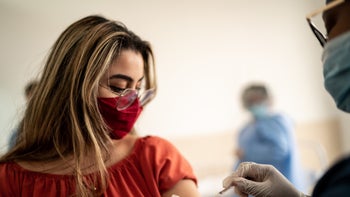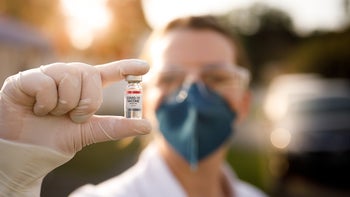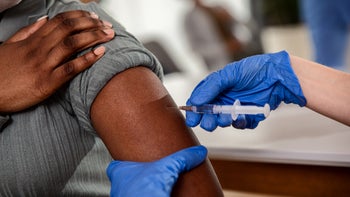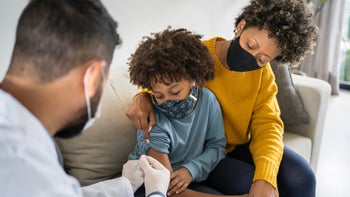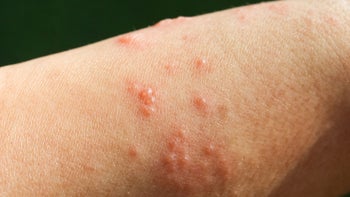
Travel Vaccines: How to Get Vaccinated for Yellow Fever, Malaria, and More
Key takeaways:
Yellow fever, MMR (measles, mumps, rubella), and hepatitis A are a few examples of vaccines you may need before traveling. The specific vaccine(s) you’ll need depends on your destination.
Some travel vaccines are given more often than others. For instance, the yellow fever vaccine offers lifelong protection for most people. But typhoid vaccine boosters are recommended every 2 to 5 years.
The typical yellow fever vaccine cost is around $170 — but this can vary by clinic and location. GoodRx can help make your travel vaccines more affordable.
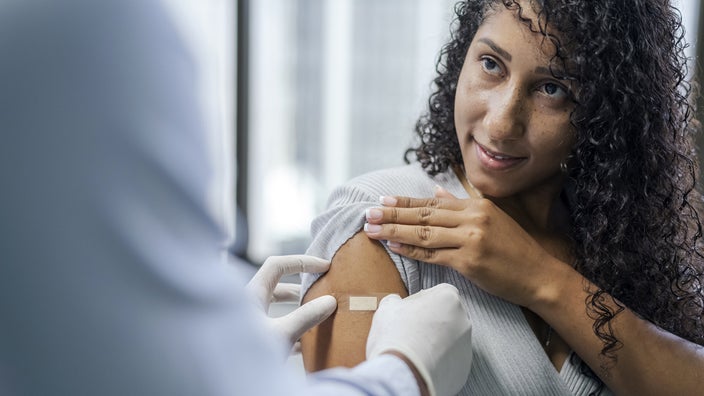
Planning an international trip can be an exciting time for you and your family. Whether you’re traveling by plane or cruising to your destination, you likely have a checklist of fun places to eat and visit. But staying healthy should also be at the top of your priority list.
Depending on where you’re traveling, you may need some vaccinations — like a yellow fever vaccine — to protect you from certain illnesses. Being up to date with your vaccines can help keep you and your loved ones healthy on your trip.
What vaccines do I need for travel?
The vaccine(s) you’ll need depends on your destination. It’s important to make sure you’re current on both routine and travel vaccines before your trip. Reach out to your healthcare provider to see if you need any of these vaccines before your trip:
If you or your child never received the MMR vaccine, it’s a good one to put at the top of your to-do list before traveling. Routine vaccinations — including those with MMR vaccines — dropped drastically during the COVID pandemic. In fact, almost 40 million kids worldwide missed an MMR dose in 2021. Babies traveling to countries with high rates of measles should get a measles vaccine before traveling.
What factors are involved in choosing the right travel vaccines?
You can search the CDC’s travel health page online to find out which vaccines are important based on where you’re going. Your healthcare provider can also help you with this.
These are some important factors to consider about travel vaccines before you set out on your adventure or business trip:
Which cities/countries are you visiting? For example, if you’re traveling to rural or agricultural areas in Asia or the Western Pacific, then your healthcare provider may recommend the JE vaccine (Ixiaro). JE is spread through infected mosquitos and may cause brain swelling.
Where are you staying (hotel, hostel, tent, cabin)? Vaccine recommendations may be different based on whether you’re staying in a hotel or spending more time outdoors.
How long are you staying there? The longer you stay in areas where certain diseases are more common, the higher your risk.
What season are you traveling? If you’re traveling to the “meningitis belt” of sub-Saharan Africa during the dry season (December to June), or performing Umrah or Hajj, your healthcare provider may recommend the meningococcal vaccine (Menactra).
What type of foods do you plan to eat? Eating out often not only increases your chances of getting traveler’s diarrhea, but also typhoid fever or hepatitis A.
What current health conditions do you have, if any? If you have a weak immune system, you may not be able to receive certain live vaccines. For example, someone with uncontrolled HIV may not be able to receive the oral typhoid vaccine (Vivotif).
Read more like this
Explore these related articles, suggested for readers like you.
Is a malaria vaccine available in the U.S.?
No. While most travel vaccines are available in the U.S., the malaria vaccine is an exception. Malaria is a disease that’s spread through infected mosquitos.
Mosquirix is the world’s first malaria vaccine for young kids. But so far it’s only available in certain African countries where malaria is common. A different malaria vaccine — known as R21/Matrix-M — was also approved in Ghana and Nigeria for kids ages 5 months to 3 years old.
Do I need a yellow fever vaccine?
The only travel vaccine that is required in certain regions of the world is the yellow fever vaccine — specifically for certain areas in Central Africa and South America. A special certificate called the International Certificate of Vaccination or Prophylaxis (“yellow card”) is given to you after vaccination. It will allow you to travel to and from these countries.
This vaccine is currently available in the U.S. You can search for a clinic near you that has the yellow fever vaccine.
Where can I get travel vaccines?
You can get travel vaccines from a variety of places. Your healthcare provider, county public health department, or even your local pharmacy are a few examples.
If you have an appointment through a primary care provider or travel clinic, your visit can usually be billed through your insurance as a medical appointment. The cost for the visit and any vaccines or medications will differ based on your insurance.
Other people like to visit travel-certified pharmacies as a one-stop shop. You can meet with a specially-trained pharmacist for a one-on-one visit and receive all your vaccines and medications at one location.
How much do travel vaccines cost?
How much you’ll pay out of pocket for travel vaccines depends on your insurance status. Routine vaccines are usually covered by most insurance companies. But some travel vaccines — like yellow fever — may not be covered. So the yellow fever vaccine cost may be on your mind. It’s unknown what the malaria vaccine cost would be in the U.S. since it’s not available yet.
The average cost of three popular travel vaccines are detailed in the table below.
There are also other ways to save on vaccinations, including travel vaccines. GoodRx can help you navigate your options, which may include GoodRx discounts or copay savings cards. You can find vaccination prices as low as $18 with a free GoodRx discount.
Do travel vaccines have side effects?
Even though you can’t get sick from travel vaccines, side effects are possible. The most common side effects of injectable vaccines are pain, redness, or swelling at the injection site. These are often mild and go away quickly. Other possible side effects include:
Tiredness
Headache
Muscle and joint aches
Mild fever
Chills
Serious side effects and reactions are rare. Talk to your pharmacist or healthcare provider if you have any concerns about vaccine side effects.
How long before traveling should I think about travel vaccines?
It’s a good idea to start thinking about travel health at least 1 month before you leave. But you may need more time if you haven’t had any routine vaccines in the past. It takes time for your body to build immunity once you’re vaccinated.
Here are a few examples of vaccines you should get in advance before you travel:
Yellow fever: This vaccine must be completed 10 days prior to travel in order for your yellow fever card to be valid. The vaccine provides lifelong protection against yellow fever for most people.
Typhoid vaccine (shot): You should receive this vaccine (Typhim Vi) at least 2 weeks before travel to allow your body time to build immunity. You also need a booster every 2 years before traveling to an area where the typhoid vaccine is recommended.
Typhoid vaccine (oral capsule): Vivotif is an oral version of the typhoid vaccine. You need to take it in 4 separate doses. The last dose should be taken at least 1 week before you travel. Boosters are needed every 5 years.
Hepatitis A vaccine: This vaccine (Havrix, Vaqta) is given as 2 injections at least 6 months apart. If you don’t have time to get the second shot before traveling, you’ll still receive partial protection from the first shot.
MMR: MMR is a routine vaccine for kids that starts at 12 months. But adults and teens who haven’t been vaccinated can receive 2 doses at least 28 days apart. Babies can receive their first dose early if they’re traveling to a high measles area, but that dose will need to be repeated later on.
Do I need malaria prevention medications?
Sometimes. Depending on where you’re traveling, your healthcare provider may recommend certain medications to prevent malaria. Since there is no malaria vaccine available in the U.S., these medications — along with mosquito repellents and bed nets — serve as extra safety precautions.
Malarone (atovaquone / proguanil), doxycycline, and chloroquine are a few examples of oral medications that prevent malaria. Malarone is started 1 to 2 days before traveling. You continue taking it for 7 days after leaving your destination. Doxycycline is started 1 to 2 days prior to travel. But you keep taking it for 4 weeks (1 month) after leaving the region with malaria. You can start chloroquine 1 to 2 weeks before travel and keep taking it for 4 weeks after you leave.
The bottom line
If you need travel vaccines, it’s best to start the process at least 1 month before you leave. Yellow fever, MMR, and typhoid are a few examples of vaccines you may need before traveling. Routine vaccines are usually covered by insurance, but travel vaccines may not be. The yellow fever vaccine cost, as well as the cost of other travel vaccines, varies by clinic and location.
Why trust our experts?



References
Centers for Disease Control and Prevention. (n.d.). Destinations.
Centers for Disease Control and Prevention. (n.d.). Search for yellow fever vaccination clinics.
Centers for Disease Control and Prevention. (2021). Malaria’s impact worldwide.
Centers for Disease Control and Prevention. (2022). Transmission of Japanese encephalitis virus.
Centers for Disease Control and Prevention. (2022). Yellow fever.
Centers for Disease Control and Prevention. (2023). Need travel vaccines? Plan ahead.
Centers for Disease Control and Prevention. (2023). Plan for travel - Measles.
Gambrell, A., et al. (2022). Estimating the number of US children susceptible to measles resulting from COVID-19 related vaccination coverage declines. Vaccine.
Hughes, M., et al. (2023). Typhoid & paratyphoid fever CDC Yellow Book 2024. Centers for Disease Control and Prevention.
McNamara, L., et al. (2023). Meningococcal disease CDC Yellow Book 2024 travel-associated infections & diseases. Centers for Disease Control and Prevention.
National Association of County and City Health Officials. (n.d.). Directory of local health departments.
Parker, S., et al. (2023). Saudi Arabia: Hajj & Umrah pilgrimages CDC Yellow Book 2024. Centers for Disease Control and Prevention.
Precision Vaccinations. (2023). Mosquirix malaria vaccine.
Tan, K., et al. (2023). Malaria CDC Yellow Book 2024 travel-associated infections & diseases. Centers for Disease Control and Prevention.
University of Oxford. (2023). University of Oxford malaria vaccine receives regulatory clearance for use in Ghana and Nigeria.
World Health Organization. (2022). Nearly 40 million children are dangerously susceptible to growing measles threat.






